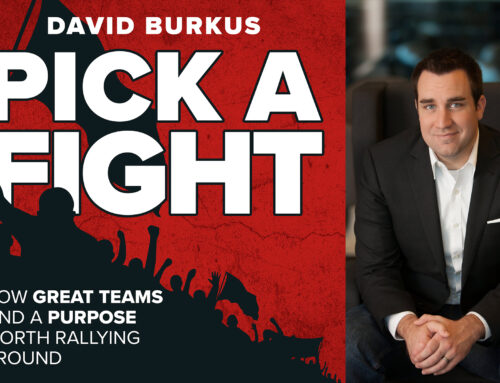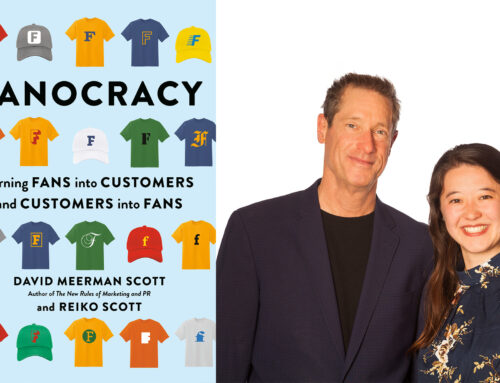The second in a series of three blogs inspired by Nicco Mele’s new book, The End of Big
Twenty-first century communication has changed how we connect to the world in three essential ways: connectivity, authenticity, and style. I discussed connectivity in the last post; this post is about authenticity.
Radical Authenticity Means Making What’s Staged Look Impromptu
We want authentic people as leaders today, and what the world doesn’t realize is how hard it is to appear that way. It takes understanding of how communications works, and it takes practice. There’s nothing spontaneous about authenticity in this televised age.
So how do you show up with pre-determined authenticity? And what about that irony of practicing authenticity? Doesn’t that mean that any such ‘authenticity’ will be fake?
Thinking about it in this way mistakes what it is and how it is projected. Authenticity is genuineness. The shortcut we use to determine it in the people around us is consistency in message and body language – does this person appear to mean what she says?
And so the irony is that the more you practice being consistent, the more likely you are to show up that way – and look authentic. When people don’t rehearse, they send out unconscious messages with their bodies that this is the first time I’m doing this. And the body language cues of first-timers overlap with the cues of people who don’t fully mean what they say. Both groups tend to engage in self-protective behavior, because they feel exposed. Both groups telegraph nervousness through agitated body language. And both groups often restrict their own motion and movement to make themselves feel safer.
The result signals to the people around us (unconsciously) that the leader is not relaxed, fluid, and at ease.
So the way to look authentic – radically authentic – is to practice. Your body must get the muscle memory of standing, walking, and talking in the ways that it will during the real event or occasion. If it does, then it can show up with some authority and presence, and your tribe will interpret that as authenticity, if the (more comfortable) body language does in fact match the message. And that is the kind of important question that gets answered by rehearsal.
If you rehearse, you and your body can focus on the moment when you’re actually delivering your message. And that greatly increases the chances that you’ll show up as authentic.











You definitely have unique take on authenticity – or radical authenticity, as you call it!
I certainly agree that vocal tone, timing, and random body language, among other things, can detract from a message – and possibly lead an audience to discount it and the speaker. And yet, today, I think audiences are sophisticated enough to see through such staging; especially staging that’s contrived to give the *appearance* of impromptu, or designed to *look* authentic.
So, practice, yes, but only to gain a feel for the flow of the content, smooth delivery of visuals, and awareness for better management of distracting behaviors…
…then, let it go and think about the people who will attend your talk…
Because true authenticity, I believe, is felt in the connection that a speaker makes with his or her audience. It is fueled by the vision and passion that drive the speaker’s beliefs and message. It’s in the energy conveyed, and goes beyond simple efforts to arrive at consistency of message and body language. If that connection with the audience is not made, then careful staging may amount to little more than smoke and mirrors.
Just my point of view, of course.
Thanks, Walter, for your comment. You’re right, you want to be able to focus on the audience and putting good energy out there for them. But the way to be able to do that is to rehearse so that you don’t look like you’re doing it for the first time. If your body language and content are in conflict, then what happens is people believe the body language every time. It’s not “careful staging,” it’s the ability to ensure that your body language supports, rather than undercuts, your message.
Thanks for your terrific response, Nick! Great clarification, and I wholeheartedly agree with you!! What I found worrisome was the implication (at least as I first read it) that we need to give the *appearance* of authenticity – which of course is inauthentic. So, I’m happy I commented, and appreciate your response!! Glad to see we’re on the same page!
Nick,
What a powerful insight–that unrehearsed and inauthentic individuals send similar non-verbal cues.
Years ago, one of my theater professors explained the purpose of rehearsals this way: “Comedy is incredibly hard. We focus on lines and blocking in rehearsal, so that we can focus our full attention on the audience when they come to see us.”
Your insight is very practical (and actionable) for anyone making a presentation. Practice until your gestures are “relaxed, fluid, and at ease.”
Let’s say I’m sitting in the audience and watching someone’s non-verbals, and the person is signaling nervousness through agitated gestures.
Are there any cues which will help me distinguish whether the person is simply unrehearsed or is truly inauthentic?
Hi, Bill — thanks for your comment and your insights from the theatrical world. To answer your question, Paul Ekman, the world’s foremost authority on lying, discovered what he called “micro expressions” a decade ago. Micro expressions are fleeting facial expressions of emotion that run counter to the dominant one currently on the face. So, for example, someone pretending to be sorry for a misdeed might flash a sneer. These micro expressions last 1/20 of a second, so they’re hard to spot, but with practice you can learn to see them. And they are a reliable way to see inauthenticity. See https://www.paulekman.com/ for more information.
As I read this post, I had the deep internal YESSSS bubble up in me. My coaching clients laugh at me when I make them rehearse what they are going to say especially in confrontational conversations. I tell them it is vital that practice what it is you are going to say and how you are going to say it so that in the moment, when your heart is racing and palms are sweaty, your communication “muscle memory” takes over can clearly communicate your point and also hear the other party’s. It is the classic communication pie chart in effect, if 55% of what communicate is body language, 38% is tone of voice that means 93% of what we communicate has nothing to do with the words coming from our mouth! I loved the way you phrased it. I will be sharing this post! Thanks!
Julia — thanks so much for your great comment, and glad we could connect!